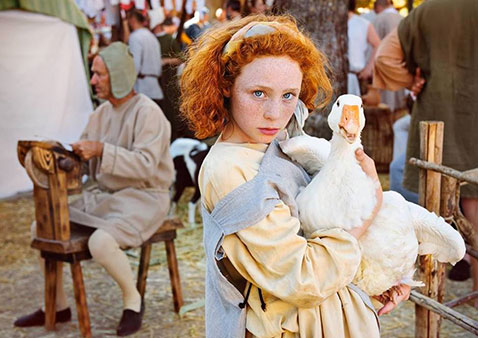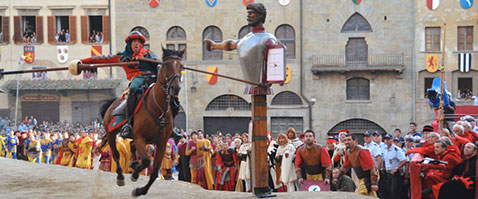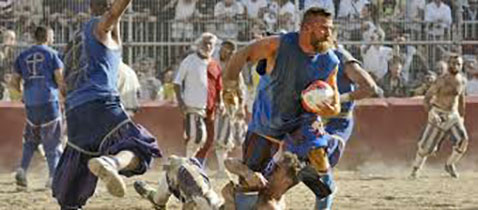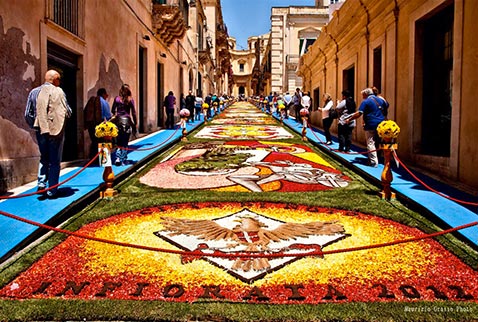If you were at Borgo di Vagli in your Tuscan residence in the coming months, below are a few attractions to consider visiting.
Gaite in Bevagna
15-25 June
Bevagna

From the study of the Statute of the Commune of Bevagna (Mevania), the medieval reenactment of the Gaite in Bevagna comes to life with its unique characteristics. The four districts, in which Bevagna was split (in the Middle Ages were called Gaite), challenge each other, playing the role that they covered in the Middle Ages and reenact with historical accuracy, the daily life of the thirteenth century. Visitors to the village, during the Gaite Market, run through a fascinating journey into the past. The ancient crafts workshops return to medieval Bevagna, with techniques and tools for processing typical crafts of the time: the painters, the mintmaster and the minting of coins, the blacksmith and the ars of bell, the ars cartaria and its large machines that reduce rags to a pulp to make paper filigree, the modelling of stain glass, the dyer, the breeding of silkworms and the production of silk yarn through the wringer, the ars tabernariorum the panicoculorum et albergatorum, processing of wax, the production of parchment, the potter, the herbalist, the art of bricks, the workshops of wrought iron, wicker and hemp.
click here for the complete program
Giostra del Saracino
June 17th
Arezzo

Twice a year Arezzo goes back to the middle ages and together with its inhabitants welcomes hundreds of spectators wanting to catch a glimpse of the ancient way of living and spirit of adventure that was the life of knights and dames.
The Joust of the Saracens, in English, originated during the Middle Ages but was revived in its actual form in 1931. Every city’s neighbourhood ("Quartieri") has a team of knights armed with lances who try jousting the “Buratto Re delle Indie”, a wooden effigy representing a Saracen warrior. The “Buratto” holds a shield with various scores: the knights’ aim is to hit it without being belted by the “mazzafrusto”, three heavy leather balls on the other Buratto’s hand.
For details click here
Calcio Storico Fiorentino
June 10 |11 |24
Piazza Santa Croce - Firenze

The Calcio Storico Fiorentino is a combination of soccer, rugby and big time wrestling which originated in 16th century Florence and is played today in historical costume. The four teams of the historical neighbourhoods of the city play against each other, first in two semi-finals and then the final match to determine the winner. The four teams are: Santa Croce (blue), Santo Spirito (white), Santa Maria Novella (red), and San Giovanni (green).
Piazza Santa Croce, located directly in front of the church Santa Croce has always been home to this game, known as “giuoco del calcio fiorentino” or more simply just as Calcio (which means “kick” in Italian). The square is covered in dirt to "return" to those times when it was just a dirt square (today it is covered in cobble stones) and recreate the setting. Of course, today bleachers are also set up so that spectators can better enjoy the game.
An hour before every game a spectacular parade takes place in the centre of Florence featuring more than 500 participants dressed in Renaissance costumes, traditional music and flags with the colours of each neighbourhood. At the end of each game there is an enormous open air banquet. Semifinal games on June 10th-11th Final game June 24th
Click here to book

The feast of Corpus Domini (the Body of Christ) is one of the most spectacular events in Umbria. The normally peaceful town of Spello is transformed into wonderland of flowers like none other. The streets are literally carpeted with flower petals of every imaginable color both found in nature and dyed. Teams of workers — both social and church groups — work for months planning the event that each year celebrates the feast. The day before the feast, the groups layout their designs (line drawings on large paper sheets) in the center of major streets and, within their tarp-covered tunnels, work throughout the night creating the most elaborate designs. Some are purely geometrical and others are wonderful depictions of Biblical themes. All are amazingly detailed and the result of an extraordinary amount of time and talent.
At 7am as the workers uncover their masterpieces no one is ever disappointed. It must be heart breaking to hang around for the mid-day pass after which the holy troop process down the major thoroughfare destroying the beautiful works of art. The symbolism is not lost. No matter how we endeavour to create things of lasting beauty, we all come to dust in the end. Humbling sentiments but a fantastic event.
Click here for the program